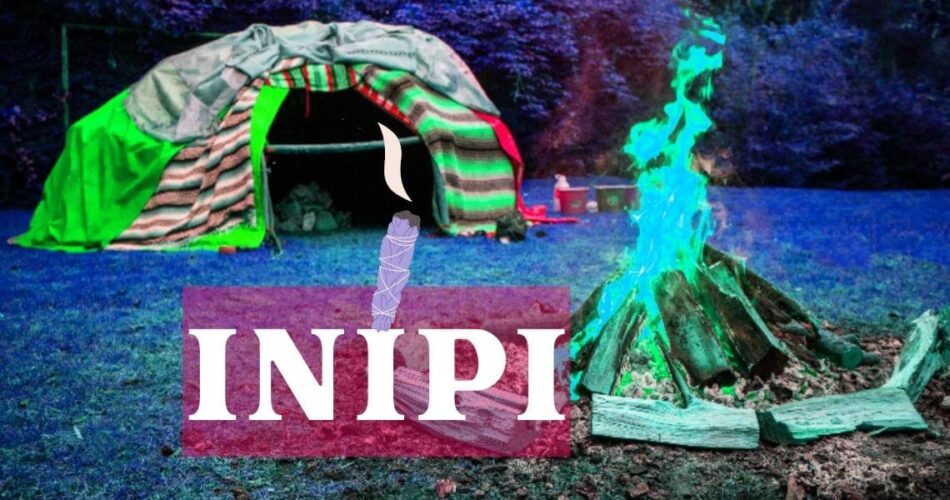Are you curious about the Native American ceremony known as inipi? It’s more than just a steam sauna. It’s a purifying ritual where indigenous people pray together. Learn more about this part of Lakota spirituality!
TL;DR
- The inipi is a traditional purification ceremony of the Lakota people 🧖
- Participants sit, pray and sing in a dark sweat lodge, filled with steam from pouring water on heated stones 🧖
- After the rite, they sit around a potluck meal and talk about their experience 🧖
Fact #1: Inipi Is a Purification Ceremony
Native American tribes believe that returning to the womb of Mother Earth allows a person to be recreated and reborn. The inipi is meant to simulate that experience, so the ceremony takes place in a dome built from willow branches and covered with cloth so that it’s completely dark inside. Purification prayers are said before and during the ritual.
Dress Code 👗
Men usually participate shirtless in loose-fitting shorts. Women put on a ribbon skirt (or another type of ankle-length skirt) and a T-shirt. For both genders, towels are recommended and no jewelry, hats or shoes are allowed. If you wear jewelry that you can’t remove, report it to the intercessor when you arrive.

Fact #2: It’s Only for the Lakota, Dakota and Nakota Nations
Though there have been reports of outsiders being allowed at inipi ceremonies (usually held in healing centers inspired by indigenous spirituality), this is frowned upon. In 1993, the Lakota, Dakota and Nakota nations unanimously decided that their Sacred Ceremonies are only for members of their tribes. It’s specified in the Declaration of War Against Exploiters of Lakota Spirituality.
Fact #3: It’s One of the Seven Sacred Ceremonies of the Lakota People
The inipi is the first of the sacred ceremonies passed down through the generations of the Lakota. The other 6 rites are:

- Crying for a Vision (Haŋbléčeyapi) – those who wish to go on a Vision Quest must first complete an Inípi;
- Sundance (Wiwáŋyaŋg Wačhípi) – practiced with a specific intention in mind;
- Making of Relatives (Huŋkálowaŋpi) – used to adopt non-members into a tribe;
- A Girl’s Coming of Age (Išnáthi Awíčhalowaŋpi) – traditionally done during a girl’s first menstruation;
- Keeping of the Soul (Wanáǧi Yuhápi) – purifying the soul of a deceased personl
- Throwing of the Ball (Tȟápa Waŋkáyeyapi) – used to heal a stressed community.
Fact #4: The Inipi Ceremony Can Last 3–6 Hours
Depending on what you count or don’t count as part of the ceremony, it can last between 3 and 6 hours. First, the sweat lodge is constructed. Participants start coming and greeting each other – “Aho!” is the traditional blessing. A fireplace is dug in the center of the lodge, around which participants sit. A larger fire pit is prepared outside, where stones are heated and then brought inside the dome.
Once the stones have been placed in the central fire pit, participants offer prayers and sing songs. Water is poured onto the heated stones to create steam, which fills the lodge and induces sweating, a symbol of purification and cleansing. The inipi ceremony consists of 4 rounds (called “doors”), each marked by new stones being added to the pit.

At the end, a ceremonial pipe is smoked and food is passed around. After the ceremony, the participants leave the lodge and enjoy a potluck meal and share their experiences, visions, and messages with others.
Fact #5: Fake Sweat Lodge Ceremonies Can Be Dangerous
Watch out for inipi “ceremonies” performed by outsiders! Without a trained healer leading and supervising the sweatlodge, dangerous errors can happen. For example, the temperature in the dome can rise too high, making the participants dehydrated and even leading to a heat stroke. Serious injuries and even deaths have been connected to new-age sweats mixing Sioux teachings with occult. In contrast, traditional Lakota inipi is completely safe for everyone involved.
Fact #6: Inipi Means “Live Again” or “Rocks”
There are two accepted etymologies of inipi:
- iní– from inyan, ‘rock’ + –pi, making the term plural, ‘rocks’;
- from inikagapi, with i meaning ‘by means of,’ ni meaning ‘life’, and kagapi meaning ‘make or cause.’
The second etymology is probably the source of the claim that inipi means ‘to live again’. Regardless of the meaning, it’s part of the Lakota way and needs to be respected as a traditional means of spiritual purification rather than treated as a fun and different form of meditation.
Similar Posts:
- Ayahuasca Diet: How to Prepare Yourself for the Ceremony?
- Ayahuasca Retreat – USA Locations and Legal Considerations
- Ayahuasca Guidelines: Preparing for a Ceremony
- Are Mushrooms Legal in Mexico? Magic Mushrooms and Psilocybin in Mexican Law
- Mescaline vs Peyote Cactus: A Short Comparison
- Mexican Dream Herb (Calea Zacatechichi) – Is It Hallucinogenic?
- Ayahuasca – Death and Dangers




